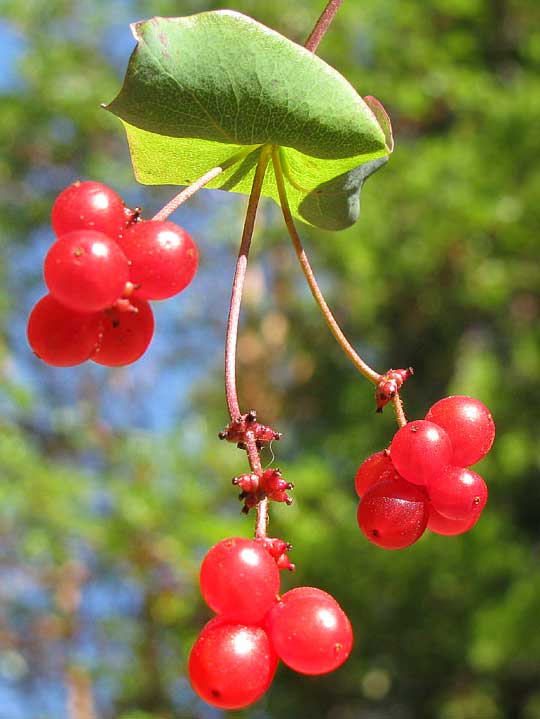Excerpts from Jim Conrad's
Naturalist Newsletter

from the the October 4, 2009 Newsletter, issued from the Siskiyou Mountains west of Grants Pass, Oregon:
PINK HONEYSUCKLE FRUITING
Another fruiting plant catching anyone's eye these days with its glossy, succulent, red fruits is shown above. Especially because of the way the fruiting heads emerge from the center of a roundish leaf, you may recognize this as a honeysuckle. It's the Pink Honeysuckle, LONICERA HISPIDULA var. VACILLANS, fairly commonly occurring here as a vine twining up shrubs along dry, sunny, weedy roadsides, at woods edges and in open woods. A few months ago the vines bore spikes of inch-long, paired, pinkish white, fragrant flowers. It's native from British Columbia along the Pacific to southern California and maybe into Mexico.
There's another closely related honeysuckle, Lonicera interrupta, with similar fruits but yellowish flowers over much of the same area where Pink Honeysuckles occur and at this time of year when flowers aren't available they could be hard to distinguish -- if you don't know a neat identification trick, or field mark. Pink Honeysuckle leaves bear very obvious stipules at the bases of their petioles, while the yellow-flowered species doesn't. The stipules are seen below:

In that picture the large white area at the left is the bottom of one of two leaves arising from a "node" on the stem (the leaves are "opposite"). At the leaf's base its short petiole curves upward to attach to the stem, and then the rounded, green, upward-flaring, ear-like thing is the stipule, with the other stipule arising opposite it.
A wide variety of birds eat the fruits.
Unfortunately the fungal pathogen causing sudden oak death, Phytophthora ramorum, inhabits Pink Honeysuckle's leaves. In some places in California and Oregon sudden oak death is killing nearly all the oaks and tanoaks, so any effort to control the disease must take into consideration the presence of this wonderful honeysuckle.